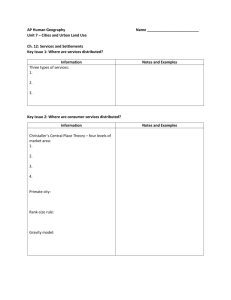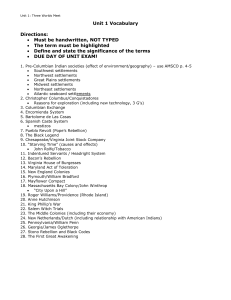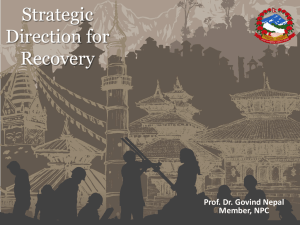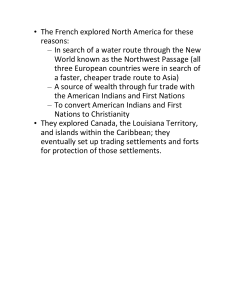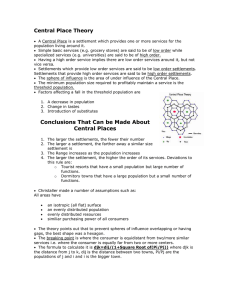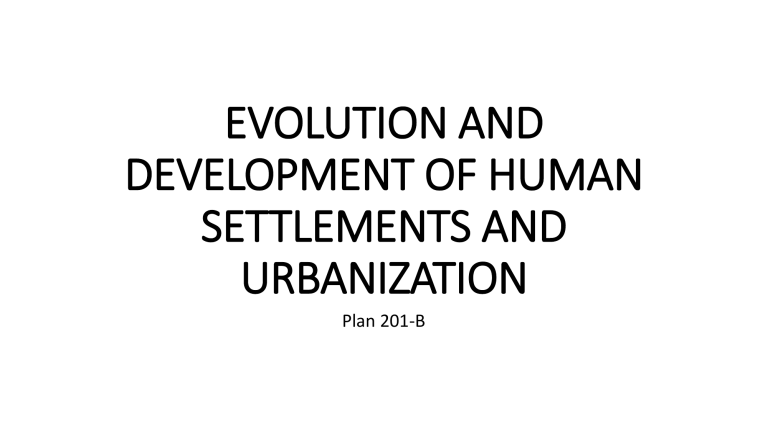
EVOLUTION AND DEVELOPMENT OF HUMAN SETTLEMENTS AND URBANIZATION Plan 201-B TOPIC: EKISTICS • Introduction to the Science of Human Settlements • Principles on the Creation of Human Settlements • Elements of Human Settlements • Basic Parts of Composite Human Settlements • Classification of Human Settlements • Evolution of Human Settlements Principles in Creation of Human Settlements 1. Maximization of Man’s potential contacts with the elements of nature (water/trees) 2. Minimization of Man’s potential contacts with the elements of nature (water/trees) 3. Mans’ protective space 4. Optimization of the quality of man’s relationship with his environment. (Nature, Man, Shells, Networks, Society) 5. Optimum synthesis of the other four principles Elements of Human Settlements 1. 2. 3. 4. 5. Nature Man Society Shells Networks Basic Parts of Composite Human Settlements 1. 2. 3. 4. Homogenous Parts – fields Central Parts – built-up villages Circulatory Parts – roads & paths within the fields Special Parts – monastery contained within the homogenous part Classification of Human Settlements 1. 2. 3. 4. 5. 6. 7. Based on Sizes - Urban or Rural Based on Location of Settlements – Plains, mountains, coastals Based on Physical Forms – expression of content, function, and structure Based on Five Elements of Human Settlements Based on Functions Based on Time Dimensions Based on degree of society’s consciousness involvement in settlements creation – natural and planned settlements 8. Based on Institutions, legislations and administrations – which society has created for settlements Classification of Human Settlements 1. 2. 3. 4. 5. By Ekistics Units By Ekistics Elements By Ekistics Functions By Evolutionary Phases By Factors & Disciplines 1. By Ekistic Units Four Basic Groups: a) Minor Shells – Man, room, house b) Micro-settlements – the traditional town c) Meso-settlements – b/w traditional town & conurbation (polis) d) Macro-settlements – largest possible expression: Ecumenopolis • Physical & Social Units – Man (smallest unit); Space, either personally owned or shared (2nd unit); Family Home (3rd Unit) • Social Unit – Group of Homes 1. By Ekistic Units Ekistics Lograthmic Scale (ELS): 1. Anthropos/Man – 1 2. Room – 2 3. House – 5 4. Hamlet – 40 5. Village – 250 6. Neighbourhood – 1.5K 7. Small Polis – 10K 8. Polis (City) – 75K 9. Small Metropolis – 500k 10. Metropolis – 4M 11. Small Megalopolis – 25M 12. Megalopolis – 150M 13. Small Eperopolis – 750M 14. Eperopolis – 7,500M 15. Ecumenopolis – 50,000M 2. By Elements 1. 2. 3. 4. 5. Nature Man Society Shells Networks 3. By Functions Important to understanding of the meaning and role of settlements 1. Reveal nature, specialization, & raison d’etre of settlements 2. Based on activity (economic, social), their performance, or special role (as dormitories, retirement villages, etc.) 4. By Evolutionary Phases 1. Macro scale – nomadic, agricultural, urban, urban industrial 2. Micro scale – specific area at a limited period of time 5. By Factors & Disciplines 1. 2. 3. 4. 5. Cultural Disciplines Economics Sociology Political Sciences Administration Technical Disciplines Ekistics • Need to have a science of human settlements (EKISTICS) • Ekistics was coined by Greek planner, Constantinos A. Doxiadis (Greek word,“oikos” (home) and “oiko” (settling down) • In order to create the cities of the future, we need to systematically develop a science of human settlements. • This science, termed Ekistics, will take into consideration the principles man takes into account when building his settlements, as well as the evolution of human settlements through history in terms of size and quality. • The target is to build the city of optimum size, that is, a city which respects human dimensions. • Since there is no point in resisting development, we should try to accommodate technological evolution and the needs of man within the same settlement. Constantinos A. Doxiadis "Ekistics starts with the premise that human settlements are susceptible of systematic investigation” INDIVIDUAL ASSIGNMENT Song Analysis https://youtu.be/KwIe _sjKeAY • Father wears his Sunday best Mother's tired, she needs a rest The kids are playing up downstairs Sister's sighing in her sleep Brother's got a date to keep He can't hang around • Our house, in the middle of our street • Our house it has a crowd There's always something happening And it's usually quite loud Our mum, she's so house-proud Nothing ever slows her down And a mess is not allowed • Father gets up late for work Mother has to iron his shirt Then she sends the kids to school Sees them off with a small kiss (Ah, ah, ah, ah) She's the one they're going to miss In lots of ways • Our house, in the middle of our street Our house, in the middle of our street • Father wears his Sunday best I remember way back then When everything was true and when We would have such a very good time Such a fine time, such a happy time And I remember how we'd play Simply waste the day away Then we'd say nothing would come between us Two dreamers • Father wears his Sunday best Mother's tired she needs a rest The kids are playing up downstairs Sister's sighing in her sleep Brother's got a date to keep He can't hang around • Our house, in the middle of our street Our house, was our castle and our keep Our house, in the middle of our street Our house, that was where we used to sleep Our house, in the middle of our street Our house Elements of Human Settlements 1. 2. 3. 4. 5. Nature – the neighborhood/ location of their house Man – Father, mother, the kids, sister, and brother. Society – the crowd of their house, the kid’s school, Shells – their house, their castle, the school Networks – their house in the middle of the street, connection between their house and the school, the church, and the workplace. The utilities that powers their house (to iron clothes, to shower) Basic Parts of Composite Human Settlements 1. Homogenous Parts – neighborhood/ location of their house 2. Central Parts – their house (being in the middle), where it has crowds and something is always happening 3. Circulatory Parts – middle of the street 4. Special Parts – the school, the church, the workplace, and how he describes his house as the castle and the keep. Classification of Human Settlements 1. 2. 3. 4. 5. By Ekistics Units By Ekistics Elements By Ekistics Functions By Evolutionary Phases By Factors & Disciplines Classification of Human Settlements 1. By Ekistics Units a) By the basic group: Their house is a Minor Settlement; and their town is a Micro-Settlement b) Units: Individually, they are considered as the smallest unit. The shared space b/w each of them as the 2nd unit. Their house as the 3rd unit. Their village/ neighborhood as the 4th or social unit. c) Ekistics Logarithmic Scale: Anthropos, Room, House, Hamlet, and Neighborhood Classification of Human Settlements 2. By Ekistic Elements a) b) c) d) e) Nature – the neighborhood/ location of their house Man – Father, mother, the kids, sister, and brother. Society – the crowd of their house, the kid’s school, Shells – their house, their castle, the school Networks – their house in the middle of the street, connection between their house and the school, the church, and the workplace. The utilities that powers their house (to iron clothes, to shower) Classification of Human Settlements 3. By Ekistic Functions • It’s main function is to house and provide shelter for the family. A place to sleep, to get a rest, to change clothes and/or iron them, and to hang around. • It is a social space for the family, and at the same time for the crowd gathering - that it’s so loud something is always happening. Classification of Human Settlements 4. By Evolutionary Phases • The environment I took from the song in a macro scale might have evolved into an urban area. By stating that their house is in the middle of the street, states that there multiple residential houses, similar to suburbia. Limited spaces also have been introduced, like the schools, and the workplace, giving us a hint that the place has evolved into an urban area. • In a micro scale, the neighborhood has been introduced to us through the house’s position in space, close proximity of schools and work places, and possible a parks/ restaurants to go for dates. Classification of Human Settlements 5. By Factors & Disciplines 1. 2. 3. 4. 5. Cultural Disciplines Economics Sociology Political Sciences Administration Technical Disciplines 5. By Factors & Disciplines 1. 2. 3. 4. 5. Cultural Disciplines Economics Sociology Political Sciences Administration Technical Disciplines What you need to do (for presentation next meeting – 5 students to be called randomly) Identify the following, based on the song: • Elements of Human Settlements • Basic Parts of Composite Human Settlements • Classification of Human Settlements • Ekistic Units • Ekistic Elements • Ekistic Functions • Evolutionary Phases • Factors and Disciplines Thank you and see you next week!
